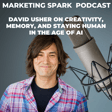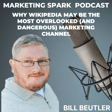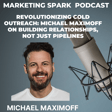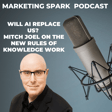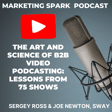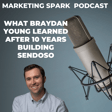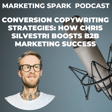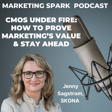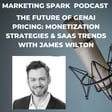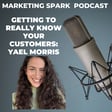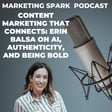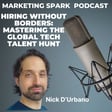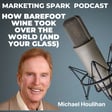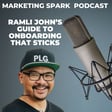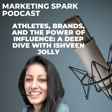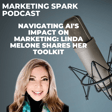Become a Creator today!Start creating today - Share your story with the world!
Start for free
00:00:00
00:00:01

How to Hire a B2B Saas Marketing Leader
Hiring a marketing leader is not just about someone's skills and experience but creating a partnership between the CEO and the head of marketing.
Avoma CEO Aditya Kothadiya provides first-hand insight into the process that he recently took to hire a director of marketing.
Aditya says one of the keys to success is hiring the right person based on a company's growth stage.
Once a marketing leader comes on board, Aditya said it is important to align around expectations and goals so the rules of engagement are established.
Transcript
Introduction to Marketing Spark and Key Guests
00:00:03
Speaker
I'm Mark Evans and welcome to Marketing Spark, the podcast that delivers insight from marketers and entrepreneurs in the trenches in 25 minutes or less.
The CEO-Marketing Partnership: Why It Matters?
00:00:13
Speaker
Successful marketing happens for many different reasons, but I would suggest that one of the keys is a strong partnership between the CEO and head of marketing.
Meet Aditya Khotidia: AI and Conversation Analysis
00:00:23
Speaker
It's an area that I'm excited to explore with Aditya Khotidia, CEO of Aboma, which delivers insight to salespeople and marketing by recording, transcribing, and analyzing conversations at scale with AI. Welcome to Marketing Spark. Thanks, Mark. This was a really great introduction and excited to be here.
Hiring for Fit: Lessons from the Journey
00:00:45
Speaker
As I said off the top, one of the keys to marketing success is a partnership between the CEO and the head of marketing. Now you recently hired a new director of marketing. Can you give me some insight about the recruiting and hiring process? How did you do the search? How long does it take? And how do you see creating that win-win partnership? A loaded question, many different assets, but I would be really interested in learning about that whole journey from having
00:01:13
Speaker
know how to marketing to having a new head of marketing? It's a loaded question and it was also an interesting journey how we hired YAG. It also came based on a lot of mistakes I had made in my previous attempts of hiring. It would be unfair to say this was the first time we tried to hire. There were fewer attempts I had done in the past and they did not work out. The number one lesson I had learned back then based on those experiences was
00:01:41
Speaker
You need to hire for the fit for the company of the stage where you are at. And it was not about the reason that some of the previous candidates did not work out was not about they were not great candidates, but because there were probably mismatch in between the expectations or they were great at certain stage of the company and where we are at. So one of the goals that I had was to
00:02:04
Speaker
find someone who is hustler at this early stage company, who can have more generalist approach rather than a specialist approach. So look for that kind of personality as well. The story with Yag is unique enough. It happened in a way where one of the things that I think this was three years ago or two years ago, when Yag was working at his previous company, it was a phrase chat where he was in the marketing department there.
00:02:32
Speaker
And I was using Intercom back then and had some concerns about Intercom's pricing, so I complained about it on Twitter. YAG pinged me on Twitter individually.
00:02:44
Speaker
and try to book a meeting with me, explain, try to address my concerns that I had with Intercom. And I remembered that conversations two years ago. And I was like, this guy is in marketing. He needs to worry about scaling, bringing more traffic at a scale, why he is hustling at an individual tweet level and trying to convert me as a customer.
00:03:06
Speaker
Since then, we got connected on LinkedIn, Twitter, and I kept watching him, all his content. We kept engaged for the last year and a half.
Strengths and Expectations in New Hires
00:03:15
Speaker
The more we started knowing each other, I realized that we need to bring him to push our brand, explain to customers what we do, which we were lagging. We were not doing a great job of doing that. That's how it was a unique process.
00:03:30
Speaker
I realized that he's the perfect fit for the stage that we have and that hustler mindset was important to me. And also he's just too nice of a guy, has been building great brand for himself, working with a lot of the community leaders. And I felt that also is a value that I would learn how to build community for what we are building. So those are the reasons we ended up bringing in YAG. To your second part of the question, how do you have the win-win situation?
00:03:57
Speaker
We are still early in our journey, but the way I felt was when I started chatting with Yag, I told him, look, you have certain strengths and I would love to learn from those. And I would want to have you continue to drive and teach me what you're doing and what you're passionate about. If I try to step in and try to give him more chores or tasks,
00:04:16
Speaker
and not play by his strength, I'm going to add more hurdle. So I told him that the number one thing that you should do is play by your strength, which is content, brand building, evangelizing. That's what you love storytelling. Continue to do that. We will continue to hire other resources in other areas over the period. But that's kind of how I'm trying to play by his strength.
00:04:38
Speaker
support him for the things that he's not great at or he doesn't probably want to do a lot more work. We'll continue to work through that process. That's how I think about it. We'll see how it gets executed over the period though. It's interesting because I think
00:04:55
Speaker
An important element of that partnership creation is establishing the rules of engagement. So both parties know what the expectations are, what the journey's gonna be like, how you measure success, what the feedback process is gonna be like, because a lot of,
00:05:13
Speaker
Relationships between CEOs and marketers fall apart when you're misaligned when the CEO has certain expectations and they fail to materialize and it becomes a blame game more than a partnership. What went wrong? Why do you do the job? Why aren't you doing your job better? Whereas it should be how can we do better? How can we as a team improve going forward? What do we need to look at? What kind of different approaches do we need to take? Do you take that into consideration when you're
Why Are CMO Tenures Short?
00:05:43
Speaker
going to be establishing a new partnership with the egg. Absolutely, and this is a great point that you brought mark one of the things that the way when you came on board. We had not worked together in the past, so the first thing I said look right now you look up to the world in certain way you have certain role models you have built your own philosophy is your value system based on what you observed read so far.
00:06:07
Speaker
I have done the same. I have some different role models. I've looked up into what I believe in the concept. And so maybe there's a mismatch right now. So what we need to do as a first thing in the first few weeks is to help us understand each other, how you get inspired from, what you like to follow more in the world, and share those stories with me so that I will understand his context. When he recommends something, when he provides a feedback,
00:06:32
Speaker
I'm instead of thinking that, oh, this is yak's feedback. And then that's very point center kind of thinking that you think about it. But now if I have a little bit more context, why did yak suggested this thing? Oh, because he followed these principles, because he believes in these kind of value system. Now I have better understanding and better context where he's coming from. Same I actually suggested yak that this is how I
00:06:56
Speaker
think about it. These are the things that I believe in these. These are my values, belief systems. And more he has understanding about those, now we don't have to do explanation. When we give feedback, Yag knows that where I'm coming from. That's kind of one of the things that we started aligning ourselves to really be going back and forth. You also talked about goals and all of those things. There's also, there is a point of view that I told him, this is what the company needs to go. This is where we want to go.
00:07:24
Speaker
What do you think? So there is a combination of bottom up. We're getting inputs from him. This is where we are at. And if you want to jump to this level, how much of this is accomplishable? Can we do this? And I might have a very high expectation as a CEO. But I want to make sure that when he comes on board, he doesn't get scared away because of those ambitious goals or lofty goals that we might have.
00:07:46
Speaker
And there is a path also to, probably you can get aggressive goals later on once he
Customer Feedback vs. Company Vision
00:07:51
Speaker
understands the rest of the ecosystem, our competitor landscape, our products, nuances, then he would be able to build up. Giving these ambitious goals for the first few weeks or first months or quarters is going to be setting up some for failure itself.
00:08:05
Speaker
So that's kind of how I also think about the goal setting itself is a collaborative process. You can't just say that, hey, this is what we want to go, go figure it out. That's where, again, you're going to set up the leaders for the failure itself.
00:08:20
Speaker
It was interesting that earlier this week, Spencer Stewart issued a study looking at the lifespan of the typical CMO, and it actually fell by one month to 40 months. So they barely last a little more than three years, whereas the average tenure for a CEO is six and a half years.
00:08:39
Speaker
curious given that you've been an entrepreneur for a long time is why do you think that cmo's don't last very long it's there almost hired to be fired is it a lack of patience a lack of understanding of marketing the pace of business is so fast how do you explain that. Honestly i would be it would be difficult to say that i know it all in this particular area.
00:09:03
Speaker
And the way I still think about it, I've also worked at larger companies where these situations have happened. So considering those lenses, the way I think about these things is that it's less about if the CEOs or the CMOs are great at the skills that they are at. It goes back to me, it's the alignment between the CEO and the CMO where CEOs or even general founders, when you think about it, they have a lot of ownership mindset that they're basically
00:09:32
Speaker
carrying this at-class shrug on their shoulders and they feel like the whole weight is on their shoulder to make the company successful. And so that end-to-end ownership mindset is what CEO thinks about. They are thinking about product, they're thinking about sales, customer experience, and all of those things. So when they're thinking about a company, positioning, story, the vision, they have a lot bigger perspective and bigger context.
00:09:56
Speaker
If the CEO has that perspective, the question is that how the other leaders in the company would have those perspectives as well, have that context as well. When you think about the alignment happens, the misalignment happens because when the CMO is trying to put some agenda that they might have or
00:10:11
Speaker
personal agenda that they're trying to bring in versus trying to put the company first, trying to understand the concept of the context of the internal vision that the CEO has. Once you understand the CEO's visions really well, then you can still take the ownership and start executing those as well. When you see that friction, that gap is there between the vision that the CEO has, and if the marketing leader is not executing based on that context, that's when I feel that CEO eventually figures out that, hey, maybe this is not working. I'm trying to communicate these things.
00:10:41
Speaker
And then I'm not seeing the results. But the results are not being seen sometimes because of these lack of the understanding itself. And that's how I still see. But honestly, there are a lot many factors could go wrong as well. But at least what comes top of my mind, this is something I would say.
00:10:58
Speaker
Let's shift gears a little bit and move to the idea that many companies need to be customer-centric, more customer-centric than ever. How much should product and market listen to customers? And when should companies not listen to customers? And I think of a quote by Henry Ford, who once said, if I had asked people what they wanted, they would have said faster horses.
00:11:20
Speaker
So as you develop your product and move forward, how much do you weigh what customers tell you versus what your vision is for the company and the product?
Successful Cold Outreach Strategies
00:11:30
Speaker
Excellent question. The way I think about this is, Mark, it's not one single answer, simple answer for every situation.
00:11:39
Speaker
This is also where I feel that you have to break it down into strategic level and then at the tactical level. At the strategic level, visual level, you've got to have a point of view as a founder, as a company. You cannot dictate that, do that based on what competitors are telling you, what customers are telling you. So you have to have your not start point of view. This is why the world is broken. This is why the world needs to be better in four years, five years. This is what the ideal state I would want to see in the world exist. You've got to have that.
00:12:09
Speaker
But at the tactical level, that's where you need to listen to the customer. So you have to have vision from your founder point of view, from the product point of view. But then when you're trying to deploy that strategy and try to deploy it in the hands of the customers, that's when if you don't listen, you're going to fail. So when the customer-centric thing is about if customer gives a feedback,
00:12:33
Speaker
Is it still aligned with your vision? If yes, listen to it and try to implement that feedback into your existing vision. And as long as it's part of the vision, you make that experience based on how they are going to experience the product or service that you're providing. But on the other hand, if it's off that region that you have, then you don't need to listen to their feedback. And that's when I would say that you need to take this from a two different lenses point of view.
00:12:58
Speaker
And I've seen this, this also helps, to be honest, the way I might be biased here. I came from a product management experience and background. And I do believe that having that product mindset does help you. If you're coming from just purely from the sales experience background, it might be a little bit of challenge because you're going to overemphasize what customers are telling you. And you have to have that habit of being curious when customers say that I need this, you need to bring that
00:13:26
Speaker
extra level of curiosity, why do you need this? And you ask three or four level of questions to truly understand the need. And then once you understand the true need, what they have, you would be able to address their need in some other point of view or other solution that you might have, which fits into your vision. That's another way of kind of finding the balance between what customers are saying, and still trying to make sure that you have the vision centric view as well.
00:13:53
Speaker
One of the reasons why you, I believe, why you hired YAG is to raise the company's profile, to become more embedded in the community, to have a very high profile evangelist who can talk about Avoma and your category. But I'm also curious about
00:14:10
Speaker
The challenge is facing companies in competitive marketplaces to break through to prospects because prospects are being inundated with marketing and sales and all kinds of other content these days. One of the areas that I wanted to ask you about is cold outreach.
00:14:26
Speaker
Because it gets a bad rap, cold email, cold telephone calls, almost surprising prospects rather than approaching people who are warm or have brand awareness. What are your thoughts about the whole idea of cold, cold marketing, cold sales? Honestly, it became bad rep because how we have executed it. I don't think it's a
00:14:48
Speaker
you cannot not have cold outbound strategy as a company if you're building something and educating something. And I also think about it's less of a sales problem. It's more of a marketing problem as well. Think about cold marketing or cold email is nothing but a free ad that you're doing and directly trying to reach out to somebody's inbox. At the end of the day, it's an ad kind of a concept. But to think about it, I get literally 50 emails every single day.
00:15:17
Speaker
somebody's trying to do selling me code email. You know what's happening? 45 out of those 50 emails are going to Google's spam box automatically without me having to do anything. Only probably four or five emails are reaching to my inbox. Why is it happening? Because we are starting to do a lot more of this personalization, automation, and all of that stuff.
00:15:39
Speaker
But at the end of the day, we are just doing automation at scale. And people are not being thoughtful, research-oriented, trying to not get personal as much. We have also, as a company, we have started implementing cold outbound strategies as well. And when we hired a few folks, early on, their expectation was, Aditya, we're going to get 30 to 40% open rate for cold email. That's the standard. That's what we have seen in the industry works.
00:16:03
Speaker
And I said, that's ludicrous. I mean, you cannot operate where trying to burn these bridges, trying to reach out to these people. Think about it. If you're only 30, 40% of people who are opening your emails, then the funnel starts from there. Only a few people are going to be interested in all of that stuff. We've implemented some frameworks, some strategies where we said, OK, how can we make it personalized? One of the simplest hack, Mark, we implemented was that every single subject line needs to be unique to the prospect, that nobody else, that subject line should not resonate with someone else.
00:16:33
Speaker
That simple hack changed our open rates from 30, 40 percent that the expectation was to 80 percent to 90 percent. It is unheard, and this is not once in a while we have seen it. Consistently, we get open rates for cold email to 80 percent, 90 percent. Then once people open the email, they see the whole personalization the way we do, they get delighted experience, and they see that they reply to us that, hey, this is one of the best cold email I've seen.
00:17:00
Speaker
Again, when we heard sales reps, they had never seen this. They told me, Aditya, we've never got responses like this. Because it was executed badly in some other organization, that's what people believe, that that's what the world we expect and we should live in. But if you put a bit of personalization, and these are also we are able to scale, we're able to not probably say hundreds of emails every day, but we're able to send 30, 40 emails every day.
00:17:26
Speaker
I would rather take that short than trying to send too many emails and have only less kind of automated responses or automated emails and not get any responses. So that's how I think, I mean, I still believe in the value of code. We have booked deals, we have closed deals, purely from the cold outbound. So I cannot control or convince enough that, hey, why you have to continue to invest in cold, because that's how you're able to control who are you going after.
00:17:54
Speaker
I don't control who's coming to inbound to me. Yes, we might educate through the marketing messaging, but if you want to go after larger customers, if you want to go after increase our average contract value, we know who are those customers and we will rather better control that journey rather than we waiting for inbound leads to come to us. That's how I still think I extremely believe in cold email, cold outreach.
Sales and Marketing Collaboration
00:18:16
Speaker
It's just that it needs to be done right.
00:18:19
Speaker
curious about whether you're using templates to do cold outreach or whether every single of those 30 to 40 emails is completely personalized. We use templates, but the way we do it, those templates do have custom variables there. And the personalization is not that I saw you on LinkedIn or just adding your first name tag and the company name tag and try to make that as a personalized thing.
00:18:48
Speaker
We try to do the research. There is a prospecting research phase where we do, hey, these are the things that we have observed customers, LinkedIn page, their company page. And we try to put that variations of different observations that we have done into spreadsheet. We try to give at least four to five minutes to each of these research.
00:19:07
Speaker
And then through that research, then obviously those fields map to the actual templates that we have. So that we were not spending way too much time in sending these personalized emails. But when Prospect receives those emails, they find it very research heavy. They find it very personal to what they're doing. And we're also not stalking people. Hey, I saw you like rugby or football and tried not to get too personal. That's not really personalization. To me, it's more about relevancy.
00:19:34
Speaker
looking at what initiatives are happening in their company and then anticipating, hey, you have done these things recently. You've announced these features in your blog. You've announced these hiring requirements. Based on that, we anticipate you might have these needs. Is this something that you would be open to learning more? And even start a conversation. We are also not trying to book a meeting in the first meeting. It's a no-no for me. You try to get one 15-minute call right there in the first meeting.
00:19:59
Speaker
We have a concept of warm up phase. First week or two, we just try to warm up the lead with sharing information, asking information. And then after those warm up phase, then we go hard selling phase in the cold email in the sequences. We do use sequences. We use templates. That's what the scaling comes in. But we want to make sure that we don't lose the touch of the personalization, the relevance when we are reaching out to these prospects.
Positioning, Messaging, and Vision Alignment
00:20:27
Speaker
So on one hand, you've got sales doing cold outreach and other forms of connecting with customers. And then you've got marketing, building community, creating content.
00:20:39
Speaker
developing sales and marketing collateral. How did the two departments work together? Because in many organizations they operate as silos. Marketing doesn't talk to sales, sales doesn't talk to marketing, sales complains that marketing leads our crap, marketing complains that sales can't close. In an ideal world, they're sitting side by side, they're comparing notes, they're working together. Is that something you think about when it comes to a VOMA?
00:21:03
Speaker
Oh, absolutely. I had this, lived with this pain in my previous companies. And I want to make sure that when we are building this organization, this doesn't become an afterthought. A lot of the times what happens is that when it's too late, when the problem is already there, and if it's too late, it gets even harder to fix it. So the best way is to start when you're already starting from the day one itself. To me, Mark, the way I think about these things, there's no one single against silver bullet that will fix this problem.
00:21:30
Speaker
The way I think about this problem is threefold. There is people itself, other crux of it. Then there is a processes that you build in the company to collaborate and work. Lastly, I call about this as a platforms as well, what platforms or tools that you're using. When you think about it, first of all, people itself, you've got to identify what are the motivations of these individuals who are there at the leadership level? How connected they are with the company's mission, company's vision?
00:21:59
Speaker
When they operate, when they propose some ideas, you can sense that are they self-centric, or are they trying to put the company as a first center? The more people are self-centric and have their own agendas, that's when the more silos starts happening. People try to operate in their own ways. And you identify people who are thinking about these things at a company level, put the company first, then you will see more collaboration happens. So that's the first thing. I continue to observe what kind of people are we bringing in? How do they operate?
00:22:29
Speaker
And if they're not doing at the same level, then you give feedback to them. That's the number one thing I would do. Obviously, then processes comes in as well. What processes have you implemented? Are they defined, documented? If they're not an early stage company, we struggle with that too much as well, because these processes are being built as we go as well. But if you don't put a little bit of thought ahead of time, then you're going to see people are working ad hoc in any manner that they want.
00:22:56
Speaker
And so documenting certain processes, then it should not be a lot of policies or restrictions. Then you're again adding more friction.
00:23:04
Speaker
As long as you talked about it, hey, this is the expectation between the collaboration. Every week, we review these numbers. Every week, we talk about the wins and failures here. And it's not about pointing finger. If you say that nothing gets discussed here, it's about identifying who made mistakes. It's about how do we improve upon the next? What do we need to do as a change as a company? So having those retrospectives is extremely important for us. So we try to have those conversations so that everyone gets aligned. That's another process that we define different
00:23:33
Speaker
mechanisms, meetings, documentations, all of those things could happen. Lastly, it comes down to platforms as well. Most of the problems I've seen happens because people are trying to access information and they don't have access to that information. So marketing is living in one different tool, and sales in living is a different tool, and both of them are not able to access that information easily. Unless marketing has to chase salespeople, let's meet, and then share only that information, then it becomes extra work.
00:24:00
Speaker
If you let people access information by themselves and have tools, adopt tools, which are collaborative in nature, you will see even more people start sharing information with each other. So to me, one of the reasons we started Obama was exactly that, that we felt that customer facing conversations are being only held into sales personnel only, or they were only having access.
00:24:23
Speaker
What we wanted to do was to democratize that intelligence that salespeople are having and have marketing people to listen to the voice of the customer firsthand, rather than listing it from the subjective opinion that the salesperson might bring in. We also led that information to heard by product people and other engineering teams. That's how we're trying to believe that the more tools and platforms you have, these collaborative platforms, you would see more collaboration between these two teams as well.
00:24:51
Speaker
I do a lot of work with B2B SaaS companies around positioning, help them tell a better, stronger, more compelling narrative. And I'm curious to see how much effort that Avoma has invested in position and in messaging. Is it something that you thought about while you've moved the company forward, while you've tried to improve your marketing and sales? This is such an excellent question. I actually think about this
00:25:19
Speaker
pretty constantly. And there's a reason we did struggle for a while to define ourselves, who we are, what we want to do. And because it happens, right? So if you don't define your own point of view, what you're trying to build as you're positioning, someone else will start building it for you. And then that might be too late for you as well. Then you get a fusion hold into one some of some set of competitors are out there as well as some sort of category that's being created.
00:25:44
Speaker
And there are a lot of things that we think about. So do we create our own category or do we try to stay in existing category and try to differentiate in the same category? And there's also a notion of
00:25:56
Speaker
Okay, you have an ambition to create own category. Who doesn't want to create their category and be number one in that category? But can you support it from a resources point of view, financial point of view? It's not just you come up with a name and tag for your company and then suddenly becomes a category. You have to invest in that. You have to educate the world. You have resources financially, team-wise, every single thing to educate the world and our analysts and all of those things.
00:26:22
Speaker
So to me it has been a challenge for us where we wanted to explain ourselves differently, but we were struggling to do that. And that's why I do keep constantly see how we are evolving as a company, how competitors are evolving, where do we compete, what are our strengths just because our competitors started positioning themselves in some way. Is that our strength?
00:26:43
Speaker
What are our strengths? Do we play by our strengths or not? And so those are the things I constantly think about. And positioning is extremely, extremely important for me. It's how we are able to explain customers who we are, why we stand. And I'm not saying that the positioning's goal is not to please everyone. It's to attract customers who believe in our vision.
00:27:04
Speaker
We will say no to a lot of customers and they'll go to our competitors. Totally fine because that's what they believe in and that's what competitors do. We don't have those things. We will stay away from that positioning and we will try not to convince those customers to buy us and eventually get disappointed. So it helps for me to convince our team because they'll come and ask me, Aditya, how we compete with these, these, these? What do we do exactly? And so I have to have that clarity in my thinking to explain them. Okay, we have these sets of customers.
00:27:34
Speaker
How does Avoma fit into all of this thing? So it helps me to communicate to my team, have them alignment. And that alignment is helpful when we make the product decisions, when we make what areas we need to decide to invest. So again, positioning is extremely important. It's not just for the marketing copy, but it goes beyond that
Recommended Reads: 'Inner Game of Tennis'
00:27:52
Speaker
marketing copy, landing page copy to how you want to execute as well. A final question just for fun. Have you read a great book recently?
00:28:01
Speaker
I did. The recent book I read, and I'm learning right now tennis, and one of the books I've read called Inner Game of Tennis. Now, it sounds like it's about tennis, but the book is about, in hindsight, it was all about the business learning. The book was about how do you perform at tennis when you are at a peak performance. And the idea was that it's not just
00:28:26
Speaker
following the routine that you have, but trying to think about your inner game when you're that level of peak performers is achieved only when you're not forcing yourself and you're letting it happen. And what it means by that, as you do more and more of these things, it becomes a habit. It becomes natural to you. If you start observing that, hey, I want to
00:28:47
Speaker
play forehand this particular way. And if you put more emphasis on putting the forehand, then you're not really executing. You're making it happen. The book was telling, let it happen. Just let the hand you tell your brain and your brain will go and make those actions. And there was a lot of great learnings. I started learning about how do we run company? How do we do these things? What are my strengths are? There are a lot of tasks. I don't enjoy doing it. And I'm forcing myself to do that. And I don't end up
00:29:17
Speaker
doing the best work of my in that particular area. For example, the whole community building, I might not be the base person. That's exactly I knew. We need to hire someone who is best studied, they enjoy doing that. And I would rather do something that I'm based on. And that's kind of that book was it's a short book. I really loved it. And I'm going to actually read that book one more time, just to again comprehend because I initially when I started reading it was about tennis coaching.
00:29:43
Speaker
Once I read it, I'm like, wow, there are a lot other lessons here. How do we run life? How do we run business that I need to read that book again? I'm also an avid tennis player and I have read the book by Timothy Galway and it is interesting because he started off as a tennis pro in this little country club.
00:30:01
Speaker
and develop this methodology or this process of teaching people how to play tennis. And then he got hired by companies around leadership and motivation and corporate culture. And it is a great story. And for anyone, even if you're not a good tennis player or you're not a tennis player, period, it's a must read. I want to ask you, if
Connect with Aditya and Mark
00:30:18
Speaker
people are interested in learning more about you and Avoma, where do they go?
00:30:22
Speaker
My email address is the best one. As long as you send my personal email, I will always reply. So it's aditya at aboma.com, A-D-I-T-Y-A, at aboma.com. Or find me on LinkedIn. That's Aditya Kothadia. On LinkedIn, just search me and you should be able to find me.
00:30:40
Speaker
Well, thanks for listening to another episode of Marketing Spark. If you enjoyed the conversation, leave a review and subscribe by iTunes, Spotify, or your favorite podcast app. For show notes of today's conversation and information about Aditya, visit marketingspark.co. If you'd like to learn more about how I help B2B SaaS companies as a fractional CMO, strategic advisor and coach, send an email to mark at markevans.ca. I'll talk to you next time.
